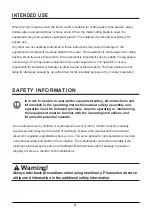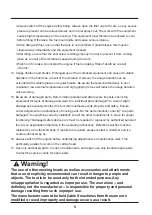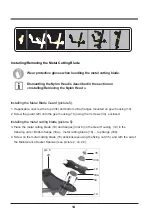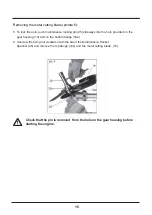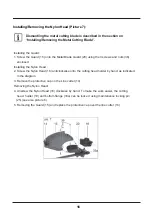
4
General Safety Information
1. Observe the surrounding conditions under which you are working. The motorized equipment
produces toxic fumes as soon as the engine is running. These gases may be odourless and
invisible. Therefore, never work with the equipment in enclosed or poorly ventilated spaces.
Ensure adequate ventilation when working. Ensure a safe stance in the wet, snow and ice, on
slopes and on uneven territory.
2. Do not allow strangers to use the equipment. Visitors and onlookers –particularly children and
people who are ill or infirm – must be kept away from the workplace. Prevent other people from
coming into contact with the tools. Do not pass on the equipment to people who are unfamiliar
with the equipment and its handling.
3. Ensure the safe transport and storage of the equipment. Always carry the equipment suspended
by the carrying strap on the tube. Equipment that is not in use must be stored in a dry place as
high up as possible or locked away to be inaccessible.
4. Always use the right tool for any work. E.g. do not use small tools or accessories for work that
should actually be performed with heavy tools. Use tools only for the purposes for which they
have been constructed.
5. Ensure appropriate clothing. Clothing must be appropriate and not impede you when working.
Wear clothing with cut protection pads.
6. Use personal protective equipment. Wear safety boots with steel caps / steel soles and
non-slip soles. Wear a hard hat if there is a risk of falling objects when working.
7. Wear safety goggles. Objects may be thrown out. Serious eye injuries may result.
8. Wear ear protection. Wear personal sound protection, e.g. earplugs.
9. Hand protection. Wear strong gloves – leather gloves offer good protection.
10. Operating the equipment. Never work without the protection on the cutting tool. Risk of injury
from objects being thrown out.
11. Remove the socket wrench etc. All keys or similar must be removed before the equipment is
switched on.
12. Stay alert at all times. Pay attention to what you are doing. Use your common sense. Do not
use motorized tools when you are tired. Work with the equipment must not be carried out under
the influence of alcohol, drugs or medications, which impair reactions.
13. Filling with fuel.
• Always adhere to the current fire regulations and the respective state/federal regulations for
fire prevention.
• Fuel and fuel fumes are highly flammable.
Do not fill with fuel when the engine is running or still hot. When filling up, ensure good
ventilation. Smoking and open flames are prohibited.



